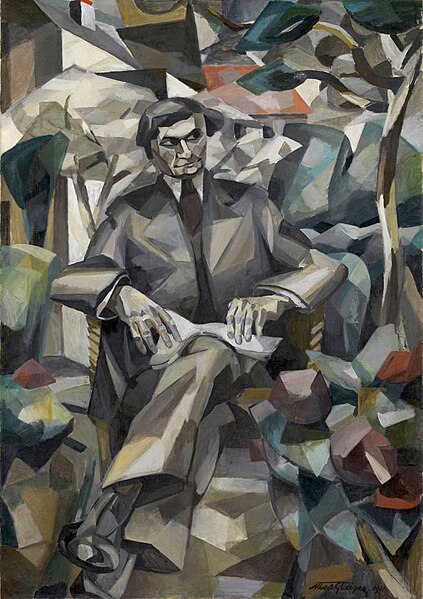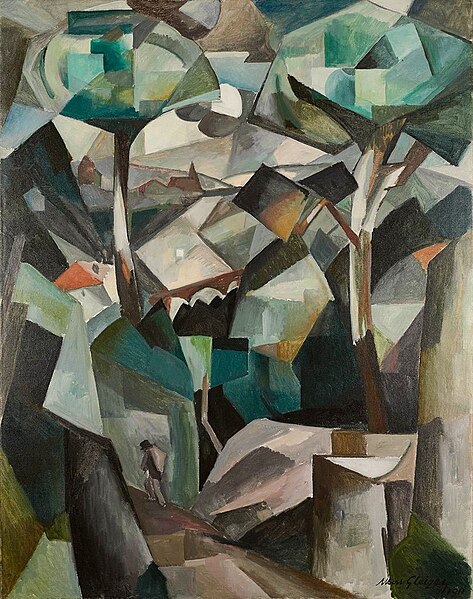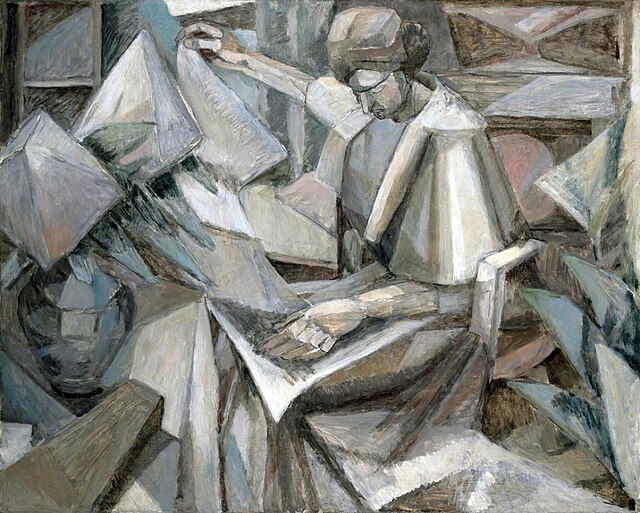Portrait of Jacques Nayral
Portrait of Jacques Nayral is a large oil painting created in 1911 by the French artist, theorist and writer Albert Gleizes (1881–1953). It was exhibited in Paris at the Salon d'Automne of 1911, the Salon de la Section d'Or, 1912, and reproduced in Du "Cubisme" written by Jean Metzinger and Albert Gleizes in 1912, the first and only manifesto on Cubism. Metzinger in 1911 described Gleizes' painting as 'a great portrait'. Portrait of Jacques Nayral, one of Gleizes' first major Cubist works, while still 'readable' in the figurative or representational sense, exemplifies the mobile, dynamic fragmentation of form characteristic of Cubism at the outset of 1911. Highly sophisticated in theory and in practice, this aspect of simultaneity would soon become identified with the practices of the Section d'Or. Here, Gleizes deploys these techniques in a radical, personal and coherent manner.
Portrait of Jacques Nayral
Page from the periodical Fantasio, 15 October 1911, featuring Portrait de Jacques Nayral by Albert Gleizes and Le goûter (Tea Time) by Jean Metzinger
Jean Metzinger, Le goûter (Tea Time), 1911, 75.9 x 70.2 cm, Philadelphia Museum of Art. Exhibited at the 1911 Salon d'Automne. André Salmon dubbed this painting "The Mona Lisa of Cubism"
Albert Gleizes, 1911, Le Chemin, Paysage à Meudon, Paysage avec personnage, oil on canvas, 146.4 × 114.4 cm. Exhibited at Salon des Indépendants, Paris, 1911, Salon des Indépendants, Brussels, 1911, Galería J. Dalmau, Barcelona, 1912, Galerie La Boétie, Salon de La Section d'Or, 1912, stolen by Nazi occupiers from the home of collector Alphonse Kann during World War II, returned to its rightful owners in 1997
Albert Gleizes was a French artist, theoretician, philosopher, a self-proclaimed founder of Cubism and an influence on the School of Paris. Albert Gleizes and Jean Metzinger wrote the first major treatise on Cubism, Du "Cubisme", 1912. Gleizes was a founding member of the Section d'Or group of artists. He was also a member of Der Sturm, and his many theoretical writings were originally most appreciated in Germany, where especially at the Bauhaus his ideas were given thoughtful consideration. Gleizes spent four crucial years in New York, and played an important role in making America aware of modern art. He was a member of the Society of Independent Artists, founder of the Ernest-Renan Association, and both a founder and participant in the Abbaye de Créteil. Gleizes exhibited regularly at Léonce Rosenberg's Galerie de l’Effort Moderne in Paris; he was also a founder, organizer and director of Abstraction-Création. From the mid-1920s to the late 1930s much of his energy went into writing, e.g., La Peinture et ses lois, Vers une conscience plastique: La Forme et l’histoire and Homocentrisme.

Albert Gleizes, c. 1920
Albert Gleizes, 1909, Bords de la Marne, oil on canvas, 54 x 65 cm, Musée des Beaux Arts de Lyon
Albert Gleizes, 1910, La Femme aux Phlox (Woman with Phlox), oil on canvas, 81 x 100 cm, exhibited Armory Show, New York, 1913, Museum of Fine Arts, Houston
Albert Gleizes, 1911, Portrait de Jacques Nayral, oil on canvas, 161.9 x 114 cm, Tate Modern, London. This painting was reproduced in Fantasio: published 15 October 1911, for the occasion of the Salon d'Automne where it was exhibited the same year.







